Japan Travel Tips
If you are considering a trip to Japan, here are a few bits of (sometimes) hard-won knowledge that was acquired during a two-month visit starting in Fukuoka on Kyushu, ending in Sapporo on Hokkaido, and visiting many points in between.
Lodging
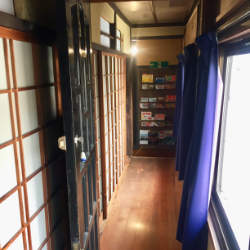
We were going the budget route with our trip which meant we were staying mostly in hostel situations. While there are downsides, we also got to interact with fellow travelers. Most of our stays were booked through Booking.com with a couple through Hostelworld.com. Hotels in Japan charge you based on occupancy rather than by room so they do tend to be more expensive. While we did find a great deal on an Airbnb in Sapporo, Airbnb has to operate as if it was a hotel and charge per person so it's often not any cheaper than a hotel. We stayed in capsule hotels a few times which were interesting places to stay and often had nice amenities. The price for capsule hotels can vary widely based on the day of the week. We stayed in one in Sendai that was very inexpensive on a Thursday night but the price went up significantly for Friday and Saturday night. When staying at a hostel or capsule hotel you're going to want to have earplugs because it's guaranteed that there will be be people going to bed after you, and getting up before you.
Internet Access
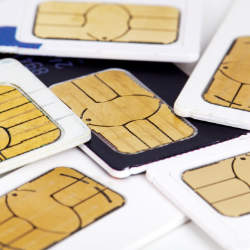
Free WiFi can be found in many places all over Japan be it JR Rail, a convenience store, or municipal WiFi. As with many free WiFi networks, they performance can be very spotty. Since we were spending two months in Japan it made sense for us to acquire Japanese SIM cards for our phones. We used Mobal and for about $100 per phone we got SIMs that were active for 60 days with 7GB/month of high speed data. After you use 7GB in a calendar month you still have data but it's throttled. That was a problem for one of us who was active on Twitter and didn't know about the mobile Twitter setting to serve reduced bandwidth content. The SIMs we got were on the SoftBank network and the speed was impressive with data rates of about 30mbps down and 15mbps up. I was also surprised that we consistently had service in subways and tunnels so I'm guessing that the stations and trains must have cell repeaters. Occasionally we wouldn't have service in a rural area but that didn't happen very often.
Swapping out SIM cards meant that we had a local phone number which came in handy when purchasing tickets for attractions online since a number of them required a local phone number, but it also meant that our US numbers were not active. With internet access I could still use communication apps like iMessage, Facebook Messenger, and What's App but I couldn't send or receive calls or texts on my US number. You will want to turn off 2-factor authentication for some of your online services because if you've got a local SIM you won't be able to get the verification text messages. While we were in Japan I suspended my US service via the Verizon website which meant I wasn't having to pay for US data that I wasn't using while out of the US.
Money
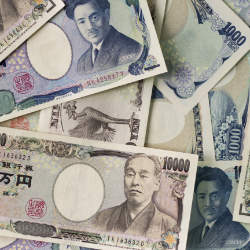
There are places that you can pay with credit cards but they are not very common. A large percentage of businesses will only accept cash. ATMs are pretty easy to find (7-11s and train stations always have them) but they usually have about a $5 transaction fee for withdrawals.
There are only three denominations of bills: 10,000¥, 5,000¥, and 1,000¥. Coins come in 500¥, 100¥, 50¥, 10¥, 5¥, and 1¥. When we were in Japan the conversion rate was pretty close to 100¥ per dollar, which made it easy to understand how much something cost. In the US it's sometimes difficult to get change for a $100 bill but in Japan we never had trouble paying with a 10,000¥ note. Since anything less than $10 comes in coin form both of us bought wallets (at Donki see below) with coin compartments to make life easier.
IC cards
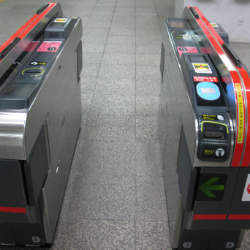
Even though credit cards are not universally accepted, IC cards can be used for trains, subways, busses, and many vending machines. Each region has their own "brand name" card. In the Tokyo area it's the Suica card, we acquired Sugoca cards on Kyushu. The cards are standardized so it doesn't matter what it's called, they will work anywhere IC cards are accepted. You can easily add money to them using a transit station kiosk. The only place we found where we couldn't use the IC cards was on the islands in the inland sea and some of the other more rural areas. In those cases we just used cash.
Transit Passes
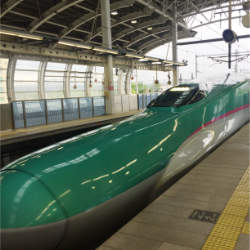
If your Japan visit lasts for 1-3 weeks it's worth looking into getting a JR pass. The high speed trains (Shinkansen) are run by JR as are the local trains in each city. Because we were in Japan for two months the JR passes didn't make sense for us. The trolleys and busses are generally not operated by JR and the subways are usually run by the city. In Tokyo you can get a 3-day Metro pass that's reasonably priced but we passed on that too because when we needed to get somewhere, it almost always required connections to a JR train or bus in addition to the Metro.
Trains and Subways
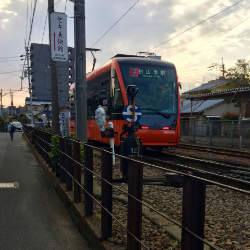
If you're going to be doing any significant traveling using trains and subways you really need to get yourself an IC card because it will save you a lot of time and hassle. When you enter a station you scan the card at the turnstile. You can leave the card in your wallet and just tap the wallet on the reader. You can often transfer to other lines without exiting the station. When you finally leave you tap the card as you're leaving and it deducts the money from the card. Most of the turnstiles will also display the cost and the remaining balance. You can also check the balance on the kiosk that you use for adding money.
Busses
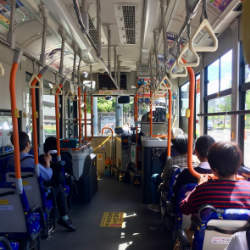
The bus systems are very good in most of Japan. The busses in the cities run often and cover most of the city. The longer range busses to get from city to city that run less frequently. The posted bus schedules have numbers in two columns and took us a minute to figure out. The left column is the hour and the numbers in the right column are the minutes in the hour that the busses are scheduled to arrive. So if you see "10" in the fist column and "17 37 57" in the second, a bus should arrive at 10:17, 10:37, and 10:57. Japan uses 24 hour time notation so unless you've got that ingrained from military service you'll have to get used to it.
For the longer range busses it's possible to purchase tickets from a bus station but it's not required. When you get on a bus, if there's a back door, that's where you enter. If you've got an IC card you scan it when you get on and then again when you get off. If you don't use an IC card you take a small slip of paper that it dispensed. It will have a number on that will determine what you pay up front when you exit. There is a display at the front of the bus that shows prices alongside the ticket numbers so you can see what it's going to cost. The longer you stay on, the higher the price goes for your number.
Navigation
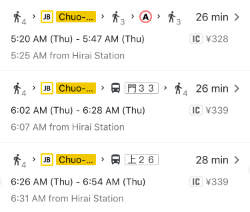
Google maps does a great job with transit directions for public transit such as trains, subways, and trolleys but we found it lacking for busses. With the trains it would even route you to the proper station platform and give you the time and fare information. Since GPS doesn't work very well inside station you will need to keep an eye out for the name of the line that you're going to be riding. For busses it wasn't always very good at getting you to the stop and sometimes it would send you to the wrong side of the street. For local busses you could easily figure it out by getting on the correct side based on travel direction and then look for the right bus number. For busses between cities that was more difficult to do since they might be doing a little looping town to pick up riders. Several times we were assisted by an obaachan (grandma) when we were at the wrong bus stop.
Quick Food
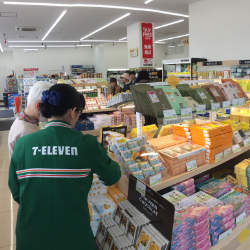
For drinks you can find vending machines literally everywhere in Japan. For between 100¥ and 160¥ you can get a soft drink, water, coffee, tea, or sports drink. Some machines also dispense hot drinks (look for a red background label "あたたかい" - usually coffee or milk tea, sometimes a hot cocoa equivalent). Some machines take paper money or IC cards but all of them take coins. They don't accept 5¥ or 1¥ coins so it was always my goal to pay with exact change when buying things with cash so those coins wouldn't accumulate.
Convenience stores, known as konbini, are awesome in Japan. You're never far from a Lawson, 7-11, or Family Mart. Unlike their US counterparts these are clean and offer actual food at reasonable prices. We bought onigiri (rice often with meat fillings that you wrap in seaweed), yakitori (meat on a stick), bento boxes (lunch boxes with rice, meat, and veggies), sushi, salads, and sandwiches from konbini fairly often. For foods that are normally served warm, you may be asked if you'd like it warmed (or you can ask if they don't offer). Here's a useful article touching on konbini phrases.
Not-as-Quick Food
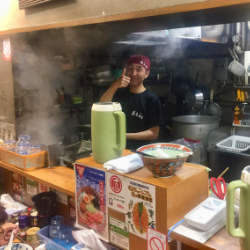
There are a plethora of small places to eat. There are chain restaurants that sell ramen and curry and these often have a pay kiosk. You insert money and then hit the button for the item you want. It spits out a ticket that you hand to the person behind the counter.
For late night meals, you can also always find an izakaya nearby. These are tiny places that often only have seven or eight seats and they sell food and drink. Some of our best meals were had at izakayas.
Food costs are usually very reasonable in Japan. When accessing the costs you need to remember that tipping isn't a thing here so the price is going to be less than you're used to paying in the US.
Fruit
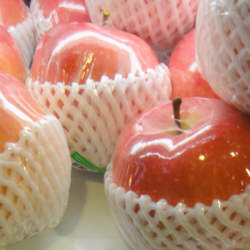
I'm used to fruit being a staple in my diet but in Japan it's more of a treat. You can get bananas and apples at super markets and konbini but they're expensive, usually around a dollar for a piece of fruit. At a supermarket in Sapporo did find bananas close to the prices you'd find in the US but more often than not you'll find two-dollar apples.
A Towel is Immensely Useful
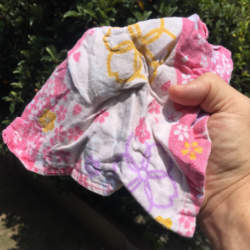
Restrooms in Japan rarely have paper towels or air driers to use after you wash your hands. While not quite as useful as it is to an interstellar hitchhiker, it's still very handy to keep a small towel in your pocket. You can buy these handkerchiefs a lot of places - Daiso or Don Quijote are good places to look, which brings us to…
Discount Stores
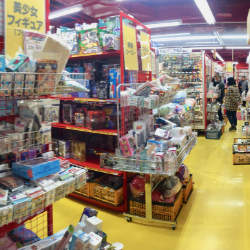
When find that you need something, just about anything, you are likely to find it at a Daiso or Don Quijote where they sell thousands of products such as food, souvenirs, cosmetics, medicine, electronic gadgets, clothes, households, games and more. To give you an idea of what a place like Don Quijote (commonly called Donki) is like, imagine a Super Walmart stuffed into half the square footage and stacked up on multiple floors. There seems to be no rhyme or reason to the organization of products but after a while you do develop a sense of where to find things.
Drug Stores
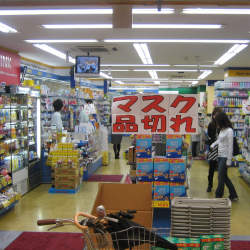
It's pretty easy to find drug store in Japan. Wherever you find a shopping street (shotengai) — which are everywhere — you will probably find a little drug store. You may have difficulty finding particular drugs and dosages for over the counter medicines in Japan. For example, ibuprofen is usually at a lower dosage. Buying it in gel capsule form gets you to the standard Advil dosage, but it's about 100¥ ($1) per pill. If you have difficulty finding things, the pharmacists there often speak some English and may be able to help you.
Attractions
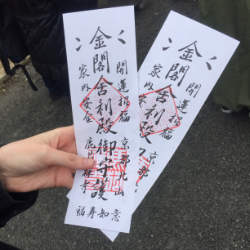
The majority of shrines and historical attractions are free but there are some exceptional ones that do charge an entry fee. Fortunately the entry fees are typically 400-500¥ ($4-5) so it's not a big deal. There are a few things that do cost more such as visiting art galleries with a traveling exhibit or a trip to the top of the Tokyo Sky Tree but even these were in the $20-25 range.
Cherry Blossoms
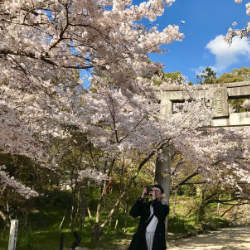
The spring is a great time to visit Japan because the weather is very nice and you're likely to catch the cherry trees in bloom. You will want to do some research online to find out when the peak bloom is going to happen in the area that you're visiting. We got very lucky in this regard because we started in the south with the trees in full bloom and we even saw cherry trees in bloom at the end of our trip up on Hokkaido.
Footwear
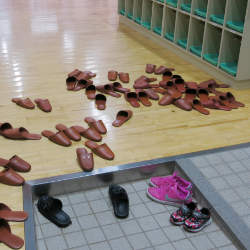
If slip on shoes work for you then you should definitely wear a pair while in Japan. Taking your shoes off when entering a house, hotel, or hostel is a given. I have some issues with my ankles and it helps to have shoes that are more securely attached to my feet so that wasn't an option for me.
Most places where you take off your shoes will provide house slippers. These are fine as long as you have fairly small feet. I wear size 10 1/2 or 11 shoes and even the largest slippers rarely fit me. If you have large feet then you might want to bring your own slippers with you.
Watch Your Head
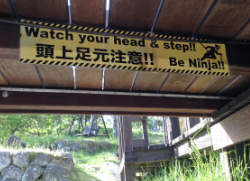
I'm six feet tall. While that's not particularly tall, it is certainly tall enough to have caused me to hit my head many times over the course of our trip. If you're really tall you're going to have to be ever vigilant here.
Firm Beds & Pillows

Most of the beds we encountered were futon beds that were fairly thin and very firm. Pillows were also very firm and in a couple of instances were actual sobakawa (buckwheat hull-filled) pillows. If you have a problem with firm beds and pillows you may not enjoy sleeping in Japan.
Onsens
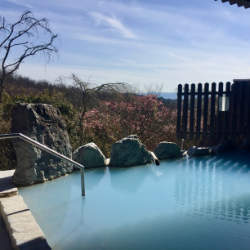
The public baths in Japan are plentiful and usually quite inexpensive, the ones we visited ranged from 500¥ to 1500¥. The men and the women each have their own baths and you don't wear any clothes. Before you go into any of the baths you thoroughly wash yourself. Some onsen provide shampoo, soap, and towels and at others you can purchase small bottles of soap and rent towels for a small fee. The baths themselves consist of different mineral baths at varying temperatures. Most that we went to were indoor but some had outdoor baths as well.
Trash
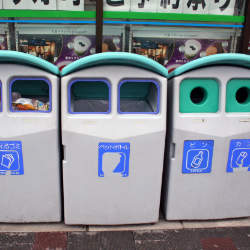
I've never seen a people more enamored with packaging. You buy a bag or box of something and all of the items in it are individually wrapped and it's virtually impossible to not have them put your purchase into a plastic bag. I've also never seen a place that's cleaner. These two observations are at direct odds with each other especially considering the lack of public trash cans. There are trash receptacles in transit stations and in konbini, and there are sometimes recycling receptacles at vending machines, but you rarely see public trash cans.
Keep in mind that trash is pretty strictly sorted in Japan - can, PET (plastic) bottle, burnable trash, and plastics/non-burnable. Fortunately most receptacles will be labeled with English and pictures indicating which is which.
Manners
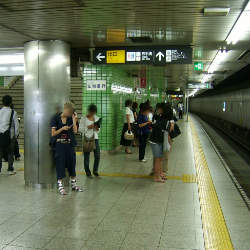
There are approximately five thousand articles on what to and what not to do in order to be polite in Japan all with conflicting opinions. I won't tackle the subject but I do recommend giving some of these a look to see what the culture is like before you go.
The most notable thing I would pass on is public transit etiquette. When boarding a bus or train, stand to the side (there are often lines indicating where to stand) and wait for people to completely exit the train before boarding. If you have a backpack, specifically on busy trains or busses, mind it - rotate it so that you're wearing it on your chest, or take it off and hold it between your feet or in front of you. This is to avoid smacking people or squishing them, and better utilizes the cramped spaces. When you're standing in an aisle and holding a handrail or grab handle, it's polite to face the seated passenger you're standing in front of (rather than sticking your butt in their face). You'll notice that trains and busses tend to be especially quiet - if you talk, keep your voice down, and if you have to take a phone call it's requested that you do so between trains. Not everyone is strict about this etiquette, but the intention is to not bother other people, a concept that's big in Japan and applicable to most situations.
That being said, if you're obviously a foreigner, you'll be given a lot of leeway for your behavior. That doesn't necessarily mean you should go be purposefully impolite, but don't hurt yourself stressing over it.
Language
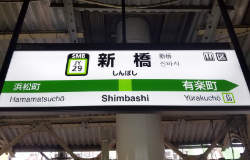
If you don't know Japanese and aren't traveling with someone with someone who does, it may be a bit difficult to get by. Many people know rudimentary English and a good majority of transit signs are in English as well as Japanese, but ordering food and getting directions could prove to be a little challenging. Fortunately a lot of restaurants either have pictures or secondary English menus, especially in more touristy areas. Still, it may be worthwhile to pick up a few travel phrases before you go, or at the very least to have Google Translate on hand. The app was really handy filling in gaps, and helped with a number of interactions where Nico's Japanese wouldn't cut it.